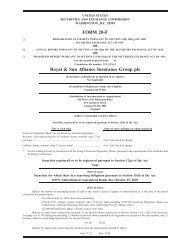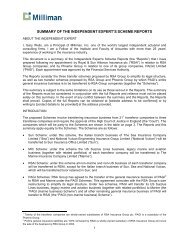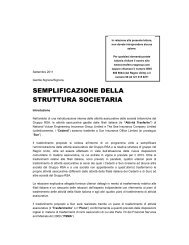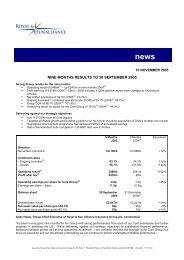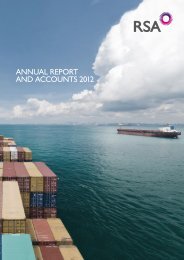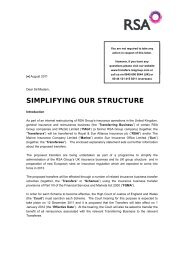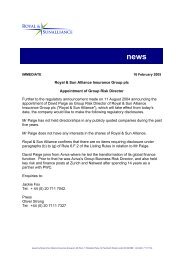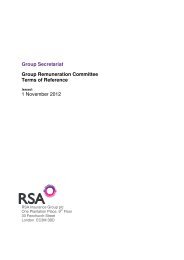PDF version of this press release - Royal and Sun Alliance
PDF version of this press release - Royal and Sun Alliance
PDF version of this press release - Royal and Sun Alliance
Create successful ePaper yourself
Turn your PDF publications into a flip-book with our unique Google optimized e-Paper software.
6. Material Contracts<br />
With the exception <strong>of</strong> the Purchase Agreement (the principal terms <strong>of</strong> which are summarised in Part IV<br />
<strong>of</strong> <strong>this</strong> document), no contracts have been entered into (other than contracts entered into in the ordinary<br />
course <strong>of</strong> business) by any member <strong>of</strong> the Group either: (i) within a period <strong>of</strong> two years immediately<br />
preceding the date <strong>of</strong> <strong>this</strong> document which are or may be material to the Group; or (ii) which contain<br />
any provisions under which any member <strong>of</strong> the Group has any obligation or entitlement which is, or<br />
may be, material to the Group as at the date <strong>of</strong> <strong>this</strong> document, <strong>and</strong> in each case, which Shareholders<br />
would reasonably require information on to make a properly informed decision on how to vote at the<br />
EGM.<br />
7. Estimation Techniques, Uncertainties <strong>and</strong> Contingencies<br />
As set out in the 2006 Interim Report <strong>of</strong> the Company for the six month period ended 30 June 2006, the<br />
following is a summary <strong>of</strong> the way in which estimation techniques, uncertainties <strong>and</strong> contingencies can<br />
affect the financial statements <strong>of</strong> insurance companies <strong>and</strong> the Group in particular.<br />
7.1 Introduction<br />
One <strong>of</strong> the purposes <strong>of</strong> insurance is to enable policyholders to protect themselves against<br />
uncertain future events. Insurance companies accept the transfer <strong>of</strong> uncertainty from<br />
policyholders <strong>and</strong> seek to add value through the aggregation <strong>and</strong> management <strong>of</strong> these risks.<br />
The uncertainty inherent in insurance is inevitably reflected in the financial statements <strong>of</strong><br />
insurance companies. The uncertainty in the financial statements principally arises in respect <strong>of</strong><br />
the insurance liabilities <strong>of</strong> the company.<br />
The insurance liabilities <strong>of</strong> an insurance company include the provision for unearned premiums<br />
<strong>and</strong> unexpired risks <strong>and</strong> the provision for outst<strong>and</strong>ing claims. Unearned premiums <strong>and</strong><br />
unexpired risks represent the amount <strong>of</strong> income set aside by the company to cover the cost <strong>of</strong><br />
claims that may arise during the unexpired period <strong>of</strong> risk <strong>of</strong> insurance policies in force at the<br />
balance sheet date. Outst<strong>and</strong>ing claims represents the company’s estimate <strong>of</strong> the cost <strong>of</strong><br />
settlement <strong>of</strong> claims that have occurred by the balance sheet date but have not yet been finally<br />
settled.<br />
In addition to the inherent uncertainty <strong>of</strong> having to make provision for future events, there is<br />
also considerable uncertainty as regards the eventual outcome <strong>of</strong> the claims that have occurred<br />
by the balance sheet date but remain unsettled. This includes claims that may have occurred but<br />
have not yet been notified to the company <strong>and</strong> those that are not yet apparent to the insured.<br />
As a consequence <strong>of</strong> <strong>this</strong> uncertainty, the insurance company needs to apply sophisticated<br />
estimation techniques to determine the appropriate provisions.<br />
7.2 Estimation techniques<br />
Claims <strong>and</strong> unexpired risks provisions are determined based upon previous claims experience,<br />
knowledge <strong>of</strong> events <strong>and</strong> the terms <strong>and</strong> conditions <strong>of</strong> the relevant policies <strong>and</strong> on interpretation<br />
<strong>of</strong> circumstances. Particularly relevant is experience with similar cases <strong>and</strong> historical claims<br />
payment trends. The approach also includes the consideration <strong>of</strong> the development <strong>of</strong> loss<br />
payment trends, the levels <strong>of</strong> unpaid claims, legislative changes, judicial decisions <strong>and</strong><br />
economic conditions.<br />
Where possible the Group adopts multiple techniques to estimate the required level <strong>of</strong><br />
provisions. This assists in giving greater underst<strong>and</strong>ing <strong>of</strong> the trends inherent in the data being<br />
projected. The Group’s estimates <strong>of</strong> losses <strong>and</strong> loss expenses are reached after a review <strong>of</strong><br />
several commonly accepted actuarial projection methodologies <strong>and</strong> a number <strong>of</strong> different bases<br />
to determine these provisions. These include methods based upon the following:<br />
s<br />
the development <strong>of</strong> previously settled claims, where payments to date are extrapolated<br />
for each prior year;<br />
21



